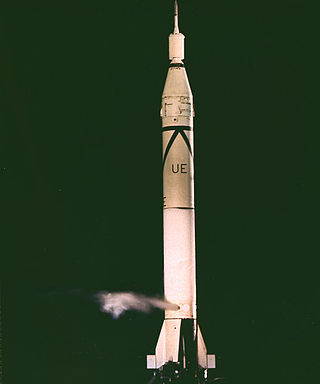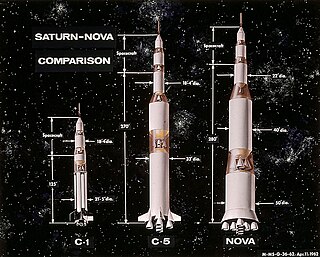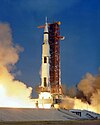Related Research Articles

Energia was a 1980s super-heavy lift launch vehicle. It was designed by NPO Energia of the Soviet Union as part of the Buran program for a variety of payloads including the Buran spacecraft. Control system main developer enterprise was the Khartron NPO "Electropribor". The Energia used four strap-on boosters each powered by a four-chamber RD-170 engine burning kerosene/LOX, and a central core stage with four single-chamber RD-0120 (11D122) engines fueled by liquid hydrogen/LOX.

The Juno I was a four-stage American space launch vehicle, used to launch lightweight payloads into low Earth orbit. The launch vehicle was used between January 1958 to December 1959. The launch vehicle is a member of the Redstone launch vehicle family, and was derived from the Jupiter-C sounding rocket. It is commonly confused with the Juno II launch vehicle, which was derived from the PGM-19 Jupiter medium-range ballistic missile. In 1958, a Juno I launch vehicle was used to launch America's first satellite, Explorer 1.

Titan was a family of United States expendable rockets used between 1959 and 2005. The Titan I and Titan II were part of the US Air Force's intercontinental ballistic missile (ICBM) fleet until 1987. The space launch vehicle versions contributed the majority of the 368 Titan launches, including all the Project Gemini crewed flights of the mid-1960s. Titan vehicles were also used to lift US military payloads as well as civilian agency reconnaissance satellites and to send interplanetary scientific probes throughout the Solar System.

The Army Ballistic Missile Agency (ABMA) was formed to develop the U.S. Army's first large ballistic missile. The agency was established at Redstone Arsenal on 1 February 1956, and commanded by Major General John B. Medaris with Wernher von Braun as technical director.

The Saturn family of American rockets was developed by a team of former German rocket engineers and scientists led by Wernher von Braun to launch heavy payloads to Earth orbit and beyond. The Saturn family used liquid hydrogen as fuel in the upper stages. Originally proposed as a military satellite launcher, they were adopted as the launch vehicles for the Apollo Moon program. Three versions were built and flown: the medium-lift Saturn I, the heavy-lift Saturn IB, and the super heavy-lift Saturn V.
The Saturn I was a rocket designed as the United States' first medium lift launch vehicle for up to 20,000-pound (9,100 kg) low Earth orbit payloads. The rocket's first stage was built as a cluster of propellant tanks engineered from older rocket tank designs, leading critics to jokingly refer to it as "Cluster's Last Stand". Its development was taken over from the Advanced Research Projects Agency (ARPA) in 1958 by the newly formed civilian NASA. Its design proved sound and flexible. It was successful in initiating the development of liquid hydrogen-fueled rocket propulsion, launching the Pegasus satellites, and flight verification of the Apollo command and service module launch phase aerodynamics. Ten Saturn I rockets were flown before it was replaced by the heavy lift derivative Saturn IB, which used a larger, higher total impulse second stage and an improved guidance and control system. It also led the way to development of the super-heavy lift Saturn V which carried the first men to landings on the Moon in the Apollo program.

Nova was a series of NASA's rocket designs that were proposed both before and after the Saturn V rocket used in the Apollo program. Nova was NASA's first large launcher proposed in 1958, for missions similar to what Saturn V was subsequently used for. The Nova and Saturn V designs closely mirrored each other in basic concept, power, size, and function. Differences were minor but practical, and the Saturn was ultimately selected for the Apollo program, largely because it would reuse existing facilities to a greater extent and could make it to the pad somewhat earlier.

The Rocketdyne H-1 was a 205,000 lbf (910 kN) thrust liquid-propellant rocket engine burning LOX and RP-1. The H-1 was developed for use in the S-I and S-IB first stages of the Saturn I and Saturn IB rockets, respectively, where it was used in clusters of eight engines. After the Apollo program, surplus H-1 engines were rebranded and reworked as the Rocketdyne RS-27 engine with first usage on the Delta 2000 series in 1974. RS-27 engines continued to be used up until 1992 when the first version of the Delta II, Delta 6000, was retired. The RS-27A variant, boasting slightly upgraded performance, was also used on the later Delta II and Delta III rockets, with the former flying until 2018.
The Saturn Vehicle Evaluation Committee, better known as the Silverstein Committee, was a US government commission assembled in 1959 to recommend specific directions that NASA could take with the Saturn rocket program. The committee was chaired by Abe Silverstein, a long-time NASA engineer, with the express intent of selecting upper stages for the Saturn after a disagreement broke out between the Air Force and Army over its development. During the meetings the Committee members outlined a number of different potential designs, including the low-risk solution von Braun was developing with existing ICBM airframes, as well as versions using entirely new upper stages developed to take full advantage of the booster stage. The advantages of using new uppers were so great that the committee won over an initially skeptical von Braun, and the future of the Saturn program changed forever.

Shuttle-derived vehicles (SDV) are space launch vehicles and spacecraft that use components, technology, and infrastructure originally developed for the Space Shuttle program.

A modular rocket is a kind of multistage rocket which has components that can interchanged for different missions. Several such rockets use similar concepts such as unified modules to minimize expenses on manufacturing, transportation and for optimization of support infrastructure for flight preparations.
Saturn A-1, studied in 1959, was projected to be the first version of Saturn I and was to be used if necessary before the S-IV liquid hydrogen second stage became available.

The Saturn C-3 was the third rocket in the Saturn C series studied from 1959 to 1962. The design was for a three-stage launch vehicle that could launch 45,000 kilograms (99,000 lb) to low Earth orbit and send 18,000 kilograms (40,000 lb) to the Moon via trans-lunar injection.
Studied in 1965, the same year that Project Gemini started, the Saturn IB-C was simply designed as an orbital launch vehicle like the original Saturn IB. The booster would consist of an ordinary Saturn IB with four Minuteman first stages used as strap-on boosters. The Saturn IB core booster did fly from 1966 until 1975, but never with its Minuteman strap-on boosters.
The Saturn V-D was a conceptual booster with the ability to launch three times as much payload as the Russian Energia booster. Studied in 1968, it was considered to be the mightiest of the proposed variations of the Saturn V rocket, rehashed as one of the boosters from the Boeing 1967 Saturn studies and utilizing the stage and a half Saturn V-B, four 100 ft tall SRBs, and the ordinary second and third stages of the original Saturn V. This booster never flew, but if it had been manufactured it would have had the capability to launch all the necessary components for a space station in one shot.

Milton William Rosen was a United States Navy engineer and project manager in the US space program between the end of World War II and the early days of the Apollo Program. He led development of the Viking and Vanguard rockets, and was influential in the critical decisions early in NASA's history that led to the definition of the Saturn rockets, which were central to the eventual success of the American Moon landing program. He died of prostate cancer in 2014.
Rocketdyne's E-1 was a liquid propellant rocket engine originally built as a backup design for the Titan I missile. While it was being developed, Heinz-Hermann Koelle at the Army Ballistic Missile Agency (ABMA) selected it as the primary engine for the rocket that would emerge as the Saturn I. In the end, the Titan went ahead with its primary engine, and the Saturn team decided to use the lower-thrust H-1 in order to speed development. The E-1 project was cancelled in 1959, but Rocketdyne's success with the design gave NASA confidence in Rocketdyne's ability to deliver the much larger F-1, which powered the first stage of the Saturn V missions to the Moon.

A super heavy-lift launch vehicle is a rocket that can lift to low Earth orbit a "super heavy payload", which is defined as more than 50 metric tons (110,000 lb) by the United States and as more than 100 metric tons (220,000 lb) by Russia. It is the most capable launch vehicle classification by mass to orbit, exceeding that of the heavy-lift launch vehicle classification.

During the lifetime of the Space Shuttle, Rockwell International and many other organizations studied various Space Shuttle designs. These involved different ways of increasing cargo and crew capacity, as well as investigating further reusability. A large focus of these designs were related to developing new shuttle boosters and improvements to the central tank, but also looked to expand NASA's ability to launch deep space missions and build modular space stations. Many of these concepts and studies would shape the concepts and programs of the 2000s such as the Constellation, Orbital Space Plane Program, and Artemis program.
References
- Bilstein, Roger E, Stages to Saturn, US Government Printing Office, 1980.
- Lowther, Scott, Saturn: Development, Details, Derivatives and Descendants, Work in progress. Available chapters may be ordered directly from Scott Lowther at web site indicated. Web Address when accessed: https://web.archive.org/web/20070521083808/http://www.webcreations.com/ptm.
